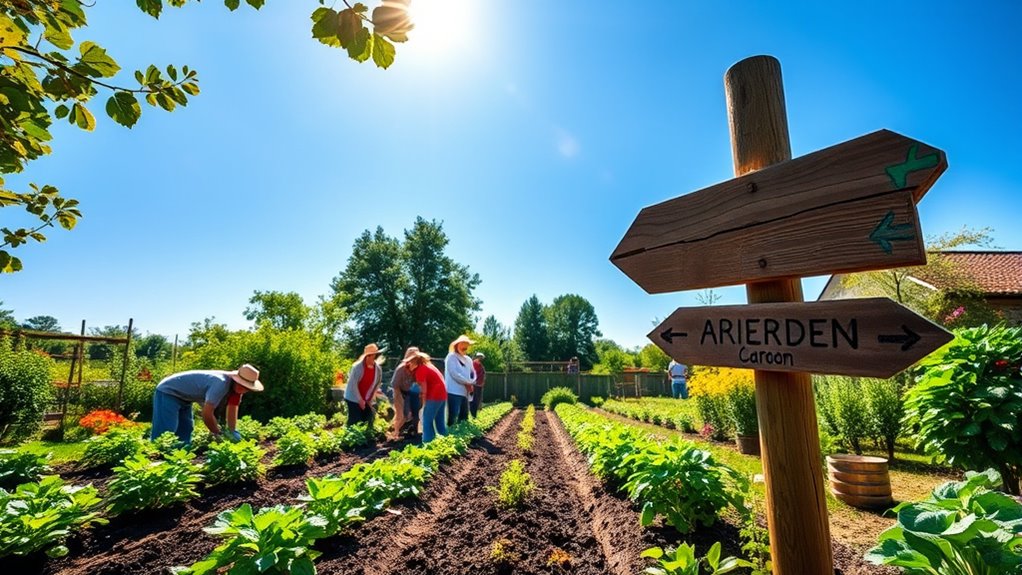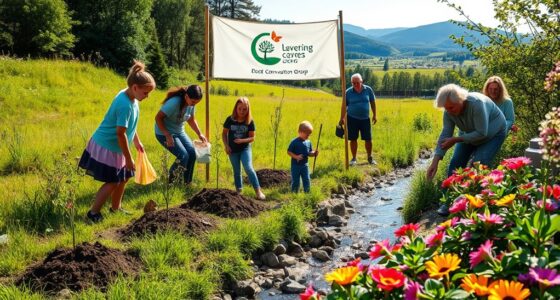Starting a community garden involves assessing local interest through surveys and meetings, selecting an accessible location with good sunlight and soil quality, and designing a space that reflects the community’s needs. You’ll also want to form a planning committee to set ground rules and manage resources effectively. Engage with community members through events to foster participation. If you’re eager to learn more about each of these steps and how to ensure the garden thrives, keep going!
Key Takeaways
- Assess community interest through surveys, public meetings, and casual conversations to gather input and support for the garden initiative.
- Select a suitable location with access to water, sunlight, and good soil while complying with local land use regulations.
- Form a planning committee to define roles, establish ground rules, and develop operational plans for resource management and sustainability.
- Implement waste management practices and safety measures to ensure a healthy and secure environment for all participants.
- Foster community engagement through organized events and activities, promoting collaboration and open communication among garden members.
Understanding Community Gardens
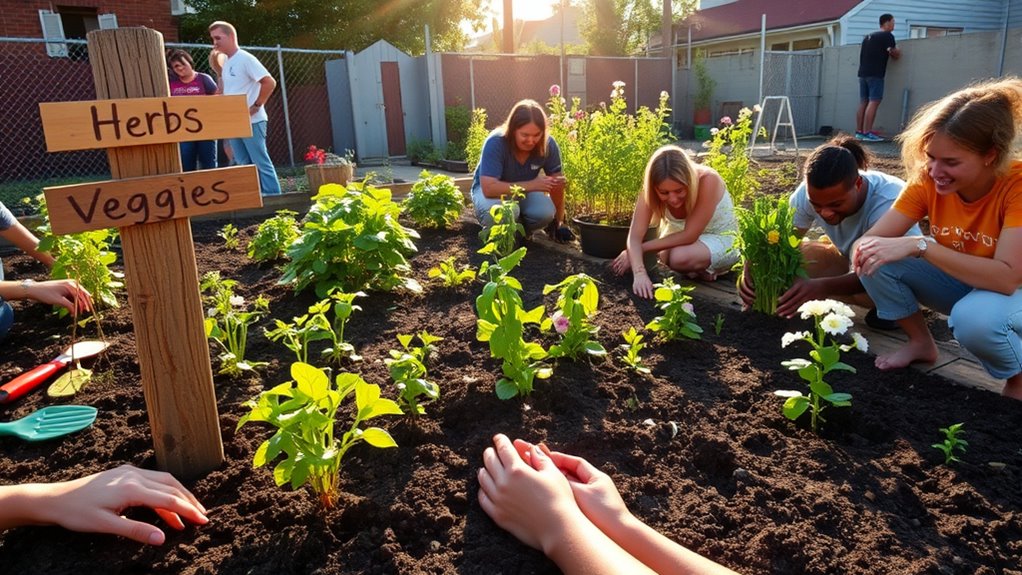
When you think about community gardens, imagine a vibrant piece of land cultivated by a group of dedicated individuals instead of just one family. These gardens aren’t managed by local governments; they thrive through the efforts of volunteers who share a passion for growing. Located in urban, suburban, or rural areas, community gardens serve multiple purposes, like food production, beautification, and education. You might find different structures, such as individual plots or shared spaces, with some gardens focusing on personal consumption while others donate produce. Educational gardens often partner with schools to promote sustainable practices, fostering cooperative efforts that enhance community engagement. Community gardens typically rely on the collective efforts of volunteers from the community for their operations. In many cases, these gardens also incorporate backyard greenhouses to extend the growing season and maximize production. Additionally, incorporating accessible design can help ensure that seniors and individuals with mobility challenges can participate fully in the gardening experience. Whether nestled in a park or on vacant lots, community gardens enrich neighborhoods, enhance food security, and foster social connections among participants.
Assessing Community Interest
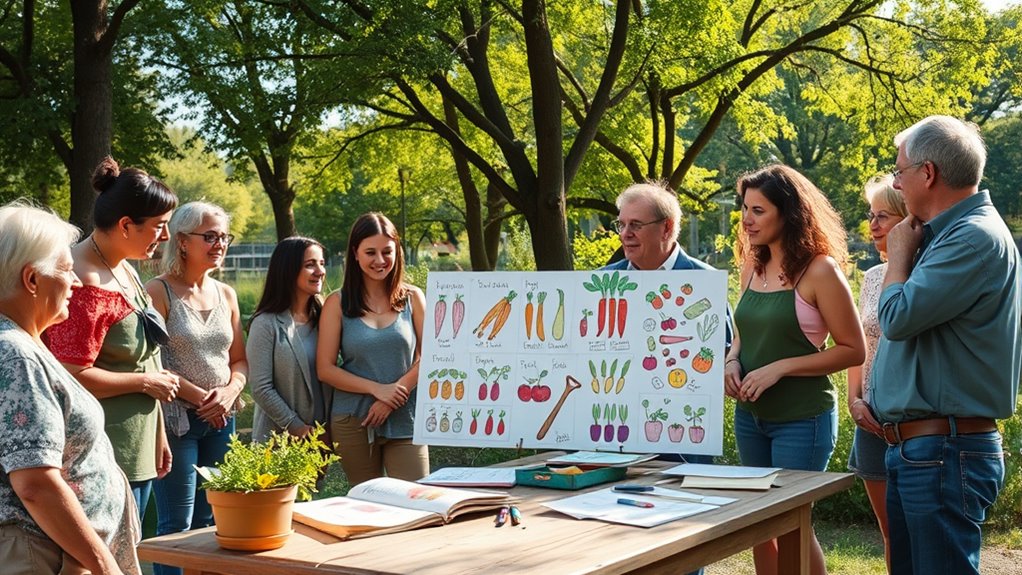
How can you effectively gauge community interest in starting a garden?
Begin by conducting surveys to gather standardized information about preferences and support. Choose between formal surveys for detailed insights or informal ones for quick feedback.
Conduct surveys to collect community preferences, opting for formal detailed insights or quick informal feedback.
Public meetings foster dialogue, allowing you to collect valuable input from attendees. Additionally, distribute flyers in local businesses and online to attract interest and encourage participation.
Engage in casual conversations to uncover community needs and desires. Establish ongoing feedback channels to maintain engagement and adapt to changing interests. Market research is an essential step that can help you understand the demographics and interests of potential participants. Consider using community gardening as a way to foster social cohesion, which can further increase community interest and involvement. Emotional damage from unmet needs in relationships can also highlight the importance of community support systems.
Collaborate with local organizations to strengthen your assessment and ensure diverse perspectives. Community gardening can also provide a platform for social cohesion, which can further increase community interest and involvement.
Selecting the Right Location
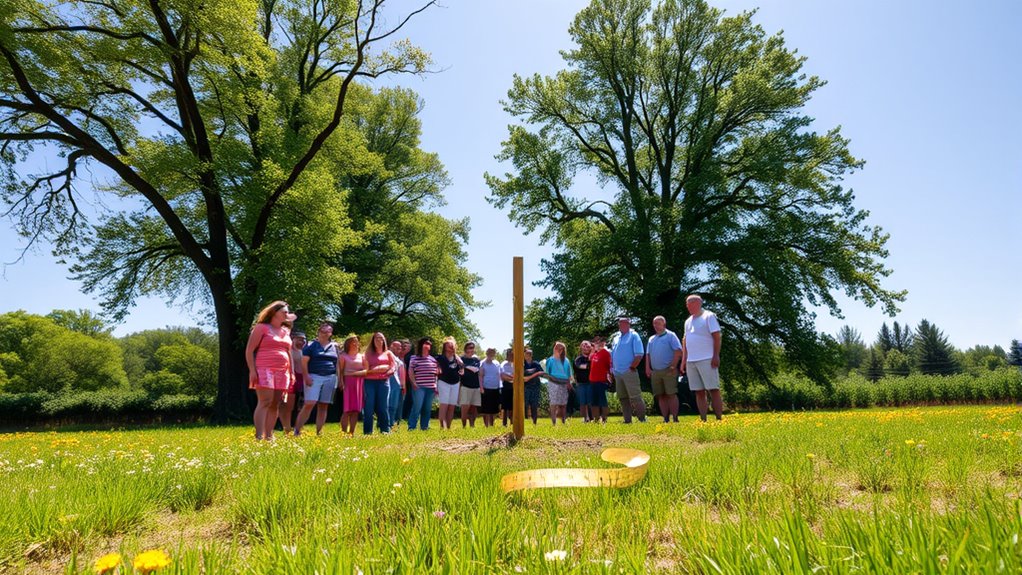
Selecting the right location for your community garden is vital to its success, as it directly impacts accessibility, engagement, and growth potential.
Choose a site that’s easily reachable by participants and ideally close to their residences. Check local regulations for using public or private land, ensuring you have the necessary permissions.
Ensure the site has access to water and drainage systems, and it receives at least six hours of sunlight daily. Assess the soil quality for nutrients and contaminants, and avoid areas prone to flooding. Moreover, having a site with clean water is essential for supporting healthy plant growth and maintaining gardener satisfaction. Additionally, consider the potential for establishing community engagement through local partnerships, which can enhance the garden’s sustainability. Incorporating organic materials into the soil can further improve its health and fertility. It is also important to consider soil quality to ensure successful plant growth and prevent contamination.
Lastly, think about the space you’ll need; each plot should be at least 4 x 6 feet, with pathways wide enough for easy access, fostering an inclusive environment for all.
Designing Your Garden
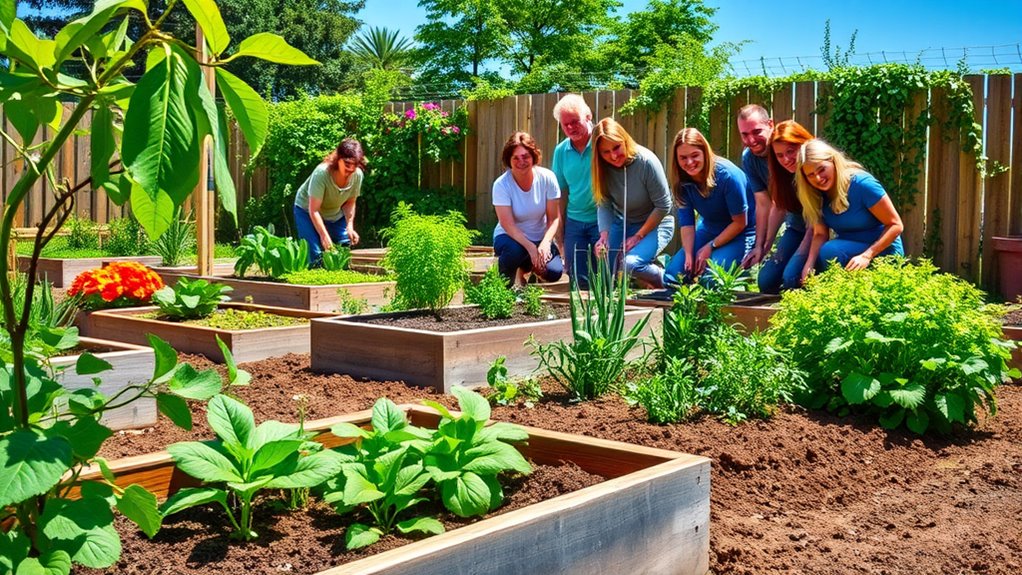
After finding the ideal location for your community garden, the next step is to design it in a way that maximizes its potential for growth and community engagement.
Start by selecting a theme that resonates with your community, whether it’s organic, floral, or vegetable. Create functional zones for planting, social interaction, and tool storage, ensuring paths are wide enough for accessibility. Consider community connections when planning your garden layout, as it can enhance the sense of belonging among participants. Incorporating sustainable practices can also help ensure the long-term success of your garden. A well-planned garden can promote sustainable living by providing fresh produce and fostering environmental awareness. Additionally, incorporating native species can enhance local biodiversity and support local wildlife.
Consider sunlight and shade when planning plot sizes, which typically range from 100 to 500 square feet. Use native plants for sustainability and aesthetic appeal while implementing efficient irrigation and drainage systems.
Lastly, incorporate spaces for workshops and events to foster community bonding and education, making your garden a welcoming hub for everyone.
Organizing a Planning Committee

To ensure your community garden starts off on the right foot, forming a planning committee is essential. Aim for a group of 6-8 dedicated individuals who can take on key roles like garden coordinator, secretary, and treasurer.
Early on, define responsibilities, establish leadership, and develop operational plans to manage resources and volunteers effectively. Engaging local stakeholders and involving them in the planning process can help establish a gardening committee to enhance community support. Research potential garden sites, considering accessibility, sunlight, soil quality, and water availability. Additionally, consider funding options that can support the ongoing maintenance of the garden. Establishing a clear governance structure is vital for ensuring long-term success and sustainability. It’s also important to foster open communication among committee members to address any challenges and ensure everyone is on the same page.
Don’t forget to discuss funding strategies to sustain the garden. By creating a clear governance structure and encouraging consistent communication, you’ll set a solid foundation for collaboration and success in your community gardening efforts.
Establishing Rules and Policies
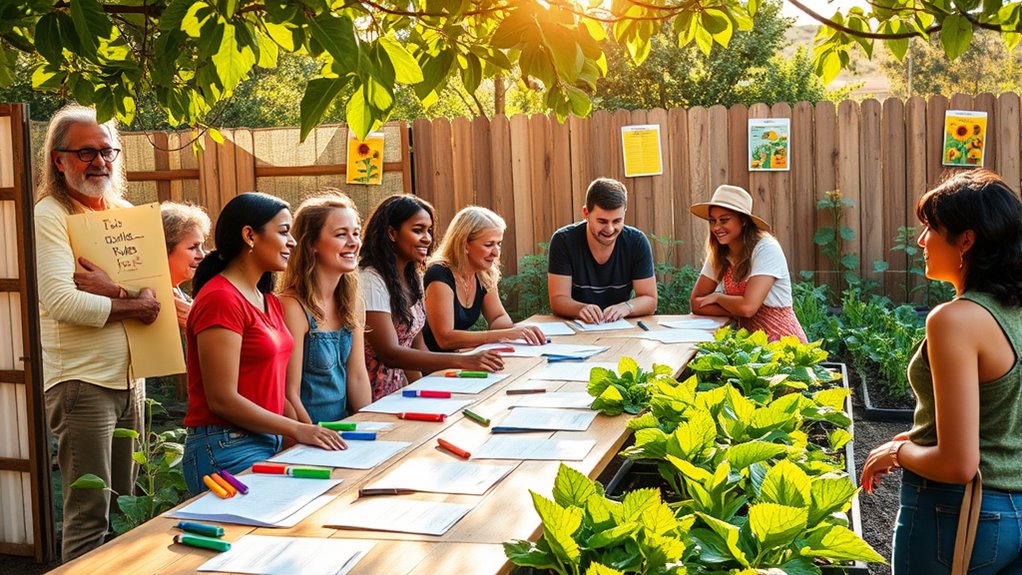
Establishing clear rules and policies is crucial for the success of your community garden, as it helps create a harmonious environment for all participants.
Start by setting ground rules for plant selection, ensuring no invasive species are planted. Each gardener must maintain their plot, keeping it free from weeds and debris. Prohibit spraying on windy days to protect neighbors, and encourage considerate planting to avoid sprawling crops. Additionally, all members must volunteer for general maintenance, especially adjacent walkways. The use of well-seasoned wood in firewood practices can serve as a great analogy for how proper maintenance and care contribute to a thriving garden. Regular compost guidelines can also help ensure that the garden remains healthy and productive. To enhance soil health, consider implementing organic farming methods that can benefit the entire garden ecosystem.
For waste management, specify compost guidelines, focusing on non-invasive materials only. Implement water conservation practices, like limiting watering times and requiring presence during watering.
Establish safety measures, such as supervising children and controlling pets.
Lastly, foster community engagement through events to strengthen relationships and promote a unified garden spirit.
Maintaining Your Community Garden
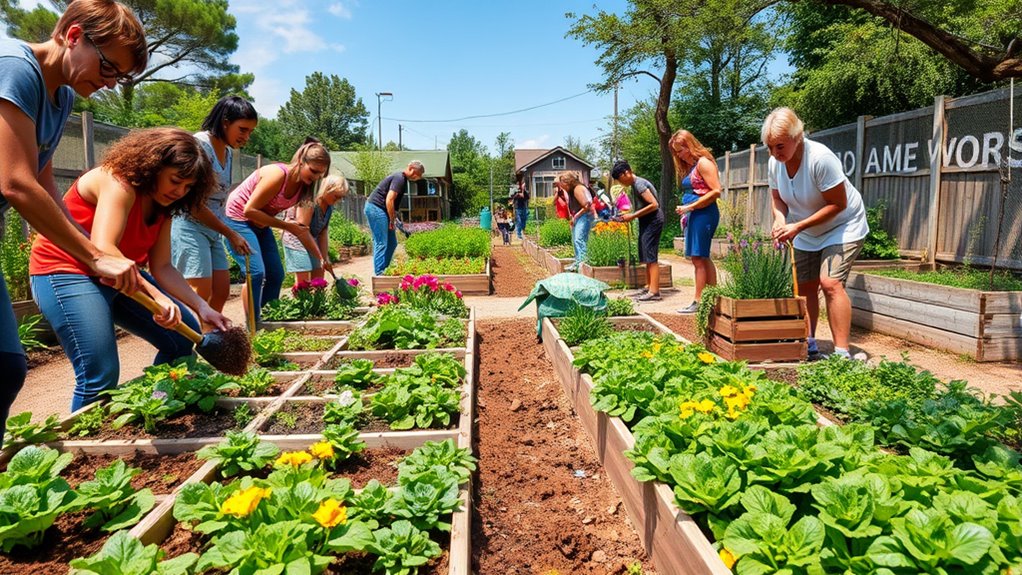
Maintaining your community garden is just as important as setting up rules and policies. Regularly manage grass and weeds by mowing and removing unwanted plants to keep the area tidy. Ensure all tools and irrigation systems are in working order to facilitate effective gardening. Implement composting to enrich soil quality and maintain healthy plants. Additionally, incorporating community members’ involvement in maintenance tasks will enhance the sense of ownership and responsibility among participants. It’s also beneficial to apply organic gardening practices to promote biodiversity and health in your garden. Furthermore, consider using educational toys or tools for children to engage them in gardening activities, fostering early interest in nature and responsibility. To further support plant health, regularly assess and rotate items to prevent clutter buildup in your gardening supplies. Don’t forget to clean up plant debris and trash to create a welcoming environment. Keep pathways clear and accessible for all members. Establish safety measures to prevent theft and vandalism, while managing access to the garden. Organize volunteer events to engage the community, and maintain open communication channels. With consistent effort, your community garden will thrive and foster a strong sense of community.
Promoting Sustainability and Expansion
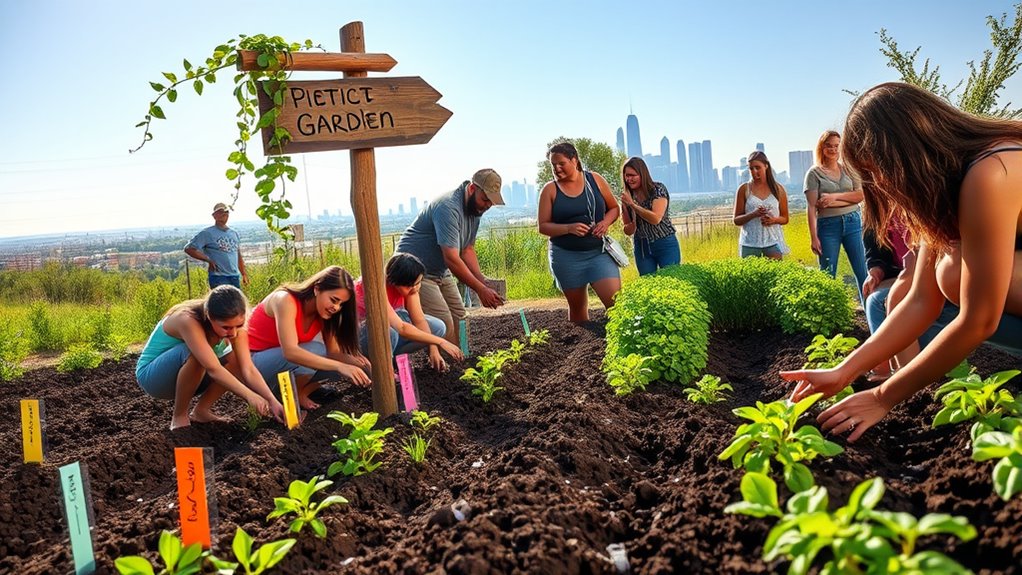
While nurturing a community garden, promoting sustainability and expansion is essential for its long-term success. You can enhance space efficiency by integrating vertical gardening and innovative hydroponics systems. Utilizing rainwater collection reduces water usage, and solar-powered irrigation cuts costs while benefiting the environment, as it leverages solar energy solutions to optimize resource management. Additionally, the use of renewable energy technologies can further enhance the sustainability of the garden’s operations. Building partnerships with local governments and organizations can provide support and funding, while engaging youth programs fosters community involvement. Additionally, community gardens serve as social hubs that strengthen community ties and foster collaboration. Organizing public events and volunteer opportunities encourages social connections and inclusivity. To boost economic viability, consider market gardens and community-supported agriculture models.
Frequently Asked Questions
How Can We Fund Our Community Garden Project?
To fund your community garden project, engage local members through grassroots fundraising events and crowdfunding.
Partner with nearby businesses for sponsorships, and utilize crowdfunding platforms like GoFundMe.
Organize fun events like seed sales or garden dinners to raise money.
Seek grants from organizations like the Captain Planet Foundation and explore support from local credit unions.
Encourage community participation to foster a sense of ownership and attract more financial backing for your initiative.
What Plants Are Best for Beginner Gardeners?
So, you think you’re ready to become the next gardening guru, huh? Well, let’s keep it simple!
For beginner gardeners, snap peas, green beans, and cucumbers are your best bets. They’re like the friendly neighbors of the plant world—easy to grow and low-maintenance.
Don’t forget about herbs like basil and mint, which practically thrive on neglect.
With these plants, you’ll be harvesting in no time, impressing friends with your “green thumb!”
How Do We Handle Conflicts Among Garden Members?
When conflicts arise among garden members, address them promptly.
Encourage direct communication between those involved; it’s often the most effective first step. If that doesn’t work, consider involving a neutral mediator to help facilitate a resolution.
Regular meetings can foster open dialogue and prevent misunderstandings.
Lastly, document any conflicts and their resolutions to track progress and maintain a harmonious community atmosphere.
Can We Incorporate Native Plants Into Our Garden?
Absolutely, you can incorporate native plants into your garden!
They’re low-maintenance, requiring less water and no extra fertilizers or pesticides. By choosing native species, you’ll attract local wildlife and support biodiversity, which enhances the ecosystem.
Plus, native plants can beautify your space and provide educational opportunities for everyone involved. Engaging your community in selecting these plants fosters ownership and cooperation, making your garden a vibrant hub for environmental stewardship.
What Should We Do During Extreme Weather Conditions?
During extreme weather, you need to stay proactive.
Monitor local forecasts daily, and use crop covers or move your plants to sheltered spots when severe weather approaches.
Choose drought or frost-resistant plants suited to your area’s conditions, and improve soil with mulch to retain moisture.
Engage your community in planning and share resources to ensure everyone’s prepared.
Conclusion
Starting a community garden can transform your neighborhood, bringing people together and fostering a love for nature. As the saying goes, “Many hands make light work.” By collaborating with your neighbors, you’ll not only create a beautiful green space but also build lasting relationships. Embrace the journey of planning, planting, and maintaining your garden, and watch it flourish. Remember, every seed you sow today has the potential to grow into something wonderful tomorrow.
